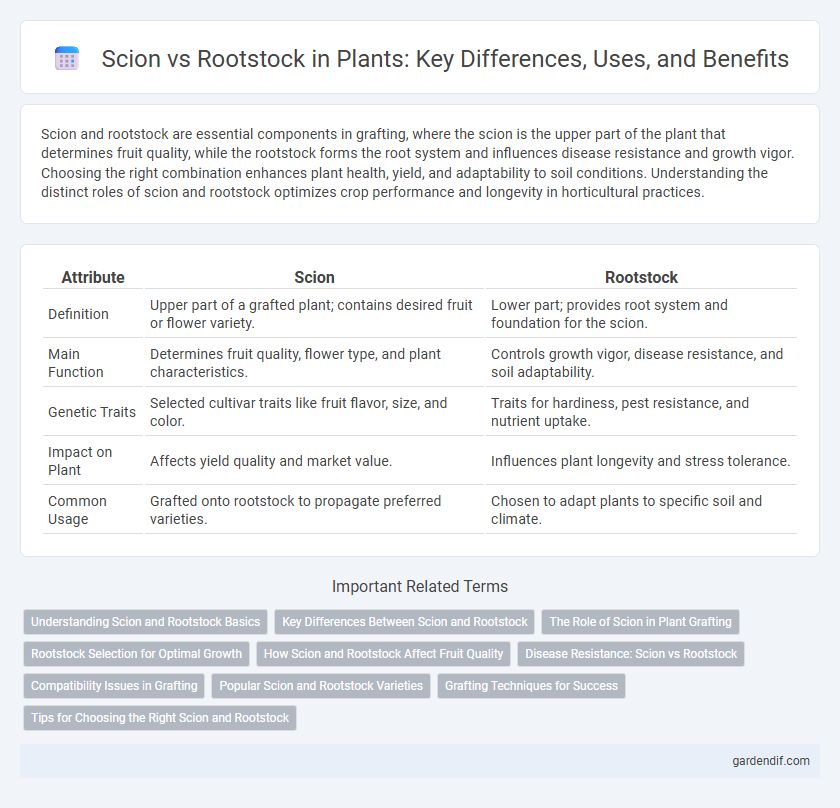
Scion vs Rootstock Illustration
Scion and rootstock are essential components in grafting, where the scion is the upper part of the plant that determines fruit quality, while the rootstock forms the root system and influences disease resistance and growth vigor. Choosing the right combination enhances plant health, yield, and adaptability to soil conditions. Understanding the distinct roles of scion and rootstock optimizes crop performance and longevity in horticultural practices.
Table of Comparison
| Attribute | Scion | Rootstock |
|---|---|---|
| Definition | Upper part of a grafted plant; contains desired fruit or flower variety. | Lower part; provides root system and foundation for the scion. |
| Main Function | Determines fruit quality, flower type, and plant characteristics. | Controls growth vigor, disease resistance, and soil adaptability. |
| Genetic Traits | Selected cultivar traits like fruit flavor, size, and color. | Traits for hardiness, pest resistance, and nutrient uptake. |
| Impact on Plant | Affects yield quality and market value. | Influences plant longevity and stress tolerance. |
| Common Usage | Grafted onto rootstock to propagate preferred varieties. | Chosen to adapt plants to specific soil and climate. |
Understanding Scion and Rootstock Basics
Scion and rootstock are fundamental components in plant grafting, where the scion is the upper part that develops into the shoots and fruits, while the rootstock forms the root system. The scion determines the plant's fruit quality, variety, and growth habit, whereas the rootstock influences disease resistance, soil adaptability, and overall vigor. Understanding the compatibility between scion and rootstock is crucial for successful grafting and optimal plant performance.
Key Differences Between Scion and Rootstock
Scion and rootstock play crucial roles in grafting, where the scion is the upper part of the plant that bears the desired fruit or flowers, and the rootstock provides the root system and influences soil adaptability, disease resistance, and overall plant vigor. Key differences include their functions: the scion determines the variety and quality of the fruit or flowers, while the rootstock controls growth rate, hardiness, and compatibility with soil conditions. Understanding these distinctions helps optimize plant health and productivity in horticulture and agriculture.
The Role of Scion in Plant Grafting
The scion plays a crucial role in plant grafting as it is the upper part of the graft that determines the fruit, flower, and leaf characteristics of the resulting plant. It is selected for its desirable traits such as disease resistance, yield quality, and growth habits, while the rootstock provides the root system and contributes to overall plant vigor and environmental adaptability. Successful grafting depends on the compatibility between the scion and rootstock to ensure proper vascular connection, nutrient flow, and long-term plant health.
Rootstock Selection for Optimal Growth
Rootstock selection critically influences plant vigor, disease resistance, and soil adaptability, directly affecting overall crop productivity. Choosing robust rootstocks such as those resistant to nematodes, Phytophthora, or drought conditions enhances root development and nutrient uptake efficiency. Optimal rootstock ensures compatibility with scion varieties, promoting uniform growth and improved fruit quality in horticultural production.
How Scion and Rootstock Affect Fruit Quality
Scion and rootstock interactions critically influence fruit quality by affecting nutrient uptake, disease resistance, and stress tolerance. The scion determines fruit characteristics such as flavor, size, and sweetness, while the rootstock impacts water and mineral absorption, altering fruit texture and shelf life. Selecting compatible scion-rootstock combinations enhances fruit yield, improves nutrient composition, and optimizes overall harvest quality.
Disease Resistance: Scion vs Rootstock
Rootstock plays a crucial role in providing disease resistance by offering a genetically resilient foundation that protects the grafted scion from soil-borne pathogens and pests. In contrast, the scion primarily contributes desirable fruit characteristics but often lacks inherent resistance to certain diseases. Selecting a rootstock with proven resistance to specific pathogens like Phytophthora, nematodes, or Verticillium wilt enhances overall plant health and longevity.
Compatibility Issues in Grafting
Compatibility issues in grafting arise when the scion and rootstock have differing genetic or physiological traits, leading to poor vascular connection and graft failure. Incompatibility can cause delayed union, reduced nutrient flow, and increased susceptibility to disease or environmental stress. Selecting compatible rootstock and scion combinations based on species, cultivar, and growth habits is essential for successful graft union and long-term plant vigor.
Popular Scion and Rootstock Varieties
Popular scion varieties include apple cultivars like Honeycrisp and Fuji, prized for their fruit quality and flavor, while widely used rootstock varieties such as M.9 and M.26 offer disease resistance and influence tree size. In grapevine cultivation, scions like Cabernet Sauvignon and Chardonnay are grafted onto rootstocks like SO4 and 1103 Paulsen to enhance pest resistance and soil adaptability. Selecting compatible scion-rootstock combinations optimizes plant vigor, yield, and stress tolerance in various horticultural practices.
Grafting Techniques for Success
Scion and rootstock play crucial roles in grafting techniques, where the scion, the desired above-ground plant part, is joined to the rootstock, which provides the root system and support. Successful grafting depends on selecting compatible species or cultivars, ensuring cambium layers of both scion and rootstock align properly to enable nutrient and water transfer. Proper graft union care, including securing the graft, maintaining moisture, and protecting from disease, significantly enhances plant growth and development.
Tips for Choosing the Right Scion and Rootstock
Selecting the right scion and rootstock involves evaluating compatibility in terms of disease resistance, climate adaptation, and growth vigor to ensure a healthy graft union and optimal fruit yield. Scions should be chosen based on desired fruit quality and market preferences, while rootstocks need to match soil conditions and provide resistance to specific pests and diseases prevalent in the area. Detailed analysis of local environmental factors and horticultural requirements enhances the success rate of grafting in commercial and home orchards.
Scion vs Rootstock Infographic

 gardendif.com
gardendif.com